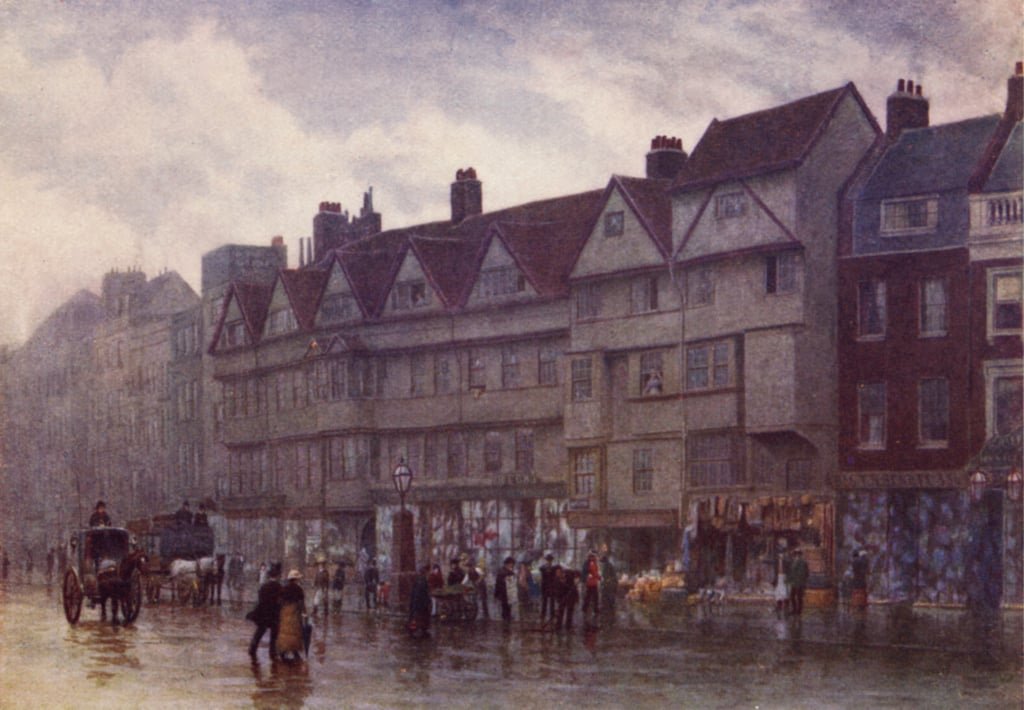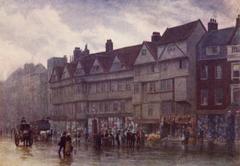
Staple Inn London: Visiting Hours, Tickets, and Historical Sites Guide
Date: 14/06/2025
Introduction to Staple Inn London
Staple Inn stands as one of London’s best-preserved Tudor-era treasures, located at 337–338 High Holborn, right in the heart of the city’s historic legal district. Built in 1585, this striking timber-framed building has survived the Great Fire of London, World War II bombings, and centuries of urban transformation. Once a center of the wool trade and later an Inn of Chancery for legal education, Staple Inn today offers a rare glimpse into London’s mercantile and legal heritage. While the building primarily houses offices—including the Institute and Faculty of Actuaries—the picturesque courtyard remains open to the public on weekdays, providing a serene oasis amid the city’s bustle.
This guide provides you with everything you need to plan your visit: up-to-date visiting hours, ticket and accessibility information, travel tips, a detailed historical overview, and recommendations for nearby attractions. Whether you’re an architecture enthusiast, a history buff, or a curious traveler, Staple Inn is a must-see destination for anyone interested in uncovering London’s layered past (Institute and Faculty of Actuaries, The London Walker, Londonist).
Contents
- Introduction
- Tudor Timber-Framed Architecture
- Historical Resilience and Restoration
- Urban Context and Landmark Status
- Cultural Significance: Wool Trade & Legal Education
- Symbolism and Popular Culture
- Visitor Information: Hours, Tickets, Accessibility
- Nearby Attractions & Travel Tips
- Visitor Experience & Practical Details
- Frequently Asked Questions (FAQ)
- Conclusion
Tudor Timber-Framed Architecture: Features and Techniques
Staple Inn’s façade—an iconic example of late Tudor timber-framed architecture—dates back to 1585 and is instantly recognizable for its black-and-white, jettied upper stories and close-studded timberwork. The building’s construction showcases hallmark Tudor techniques: exposed oak beams, gabled rooflines, leaded and bow windows, and decorative infill panels. The original five bays on the left and two on the right, both from the Tudor period but built separately, reveal subtle variations in design and technique that provide a unique comparative study of period craftsmanship (Exploring GB, Medieval London, Fordham).
In addition to its impressive exterior, the building features half-walls in the attic for improved light and headroom, as well as surviving stained glass windows—some original, others restored after wartime damage (Londonist, New2H).
Historical Resilience and Restoration
Staple Inn is among the last surviving Tudor timber-framed buildings in central London, a testament to both luck and careful restoration. Remarkably, it escaped destruction during the Great Fire of 1666, and, though damaged by bombing in World War II, was painstakingly restored to preserve its historic fabric (Londonist, New2H).
Key restoration milestones include:
- 19th-century works by architect Alfred Waterhouse, who removed later fireproof plaster to reveal the original timbering.
- Post-WWII rebuilding efforts in the 1950s, returning the façade and courtyard to their former glory.
These efforts have ensured that Staple Inn retains its unique character and remains listed as a Grade I building of exceptional interest (Wikipedia).
Urban Context and Landmark Status
Situated on the south side of High Holborn, directly opposite Chancery Lane station, Staple Inn is a historic anchor amidst modern offices and shops. The ground floor is let to commercial tenants, all required to maintain understated signage out of respect for the building’s heritage (Wikipedia). The internal courtyard, accessible via a central archway, offers a tranquil retreat from the city’s energy, preserving the building’s original layout and ambiance (Lonely Planet).
Cultural Significance: From Wool Trade to Legal Education
Staple Inn’s history is inseparable from London’s economic and legal development. In the late 13th and 14th centuries, it operated as a staple—a regulated market for the weighing and taxation of wool, England’s most important medieval export (Medieval London, Fordham). In the 15th century, it became an Inn of Chancery, providing foundational legal education and accommodations for students bound for the nearby Inns of Court, especially Gray’s Inn (Exploring GB). This dual legacy is reflected in the building’s design and ongoing use by legal and actuarial professionals.
Symbolism and Influence in Popular Culture
Staple Inn’s atmospheric façade has inspired generations of writers and artists. Charles Dickens referenced its serenity in The Mystery of Edwin Drood, and the building has been featured on Old Holborn tobacco packaging (Wikipedia, Londondrum). Its restoration in the 19th century sparked early debates about the preservation of historic buildings, highlighting the balance between conservation and modern use (Londonist).
Visitor Information: Hours, Tickets, and Accessibility
Visiting Hours:
- Monday to Friday: 9:00 AM – 5:00 PM
- Closed on weekends and public holidays (Institute and Faculty of Actuaries)
Tickets:
- Free entry to the courtyard and exterior; no tickets required
- Access to interior offices is restricted
Accessibility:
- The courtyard and street-level shops are accessible to most visitors; some cobblestone paving and a slight step at the entrance may pose challenges for wheelchair users (London Walking Tours).
- Upper floors are private and not open to the public
Facilities:
- No public restrooms on-site; nearby cafes and pubs offer facilities for customers
- No gift shop
Photography:
- Allowed in the courtyard and exterior, but respect the privacy of residents and professionals
Nearby Attractions and Travel Tips
Attractions within Walking Distance:
- The British Museum: World-class collection of art and antiquities, free entry
- Covent Garden: Markets, street performers, and shops
- Sir John Soane’s Museum: Architectural gem and house museum
- Somerset House: Art exhibitions and cultural events
- Ye Olde Mitre: Historic pub nearby
Travel Tips:
- Nearest Tube: Chancery Lane (Central Line), Holborn (Central and Piccadilly Lines)
- Several bus routes serve High Holborn
- Wear comfortable shoes for cobblestone surfaces
- Visit on weekday mornings for the quietest experience
- London’s weather is unpredictable—bring a light waterproof jacket (London in June)
Visitor Experience: Highlights and Practical Details
- Enter through the central archway into a peaceful courtyard—perfect for photography and reflection.
- The building’s decorative timberwork, bow windows, and stained glass are best appreciated in daylight.
- While the interior is not open to the public, the courtyard offers authentic Tudor atmosphere in the heart of modern London (Lonely Planet).
Frequently Asked Questions (FAQ)
Q: What are Staple Inn’s visiting hours?
A: Monday to Friday, 9:00 AM – 5:00 PM. Closed weekends and public holidays.
Q: Is there an admission fee?
A: No, visiting the exterior and courtyard is free.
Q: Is Staple Inn accessible for wheelchair users?
A: The courtyard and shops are mostly accessible, but some uneven surfaces and steps may be challenging.
Q: Are guided tours available?
A: Staple Inn is featured on many Legal London walking tours (London Walking Tours). Interior tours are rare and subject to special arrangements.
Q: Can I take photographs?
A: Yes, in the courtyard and of the exterior. Commercial photography requires permission.
Q: How do I get there by public transport?
A: Chancery Lane Underground (Central Line) is directly adjacent; Holborn station is a short walk away.
Conclusion
Staple Inn is a living monument to London’s enduring history, combining the legacy of the medieval wool trade, Tudor architecture, and centuries of legal tradition. While access is limited to public areas, the building’s façade and tranquil courtyard make it an essential stop for anyone exploring the city’s historical and architectural riches. For the latest updates on visiting hours, events, and tours, check official sources and consider downloading the Audiala app for immersive audio guides and insider tips.
Plan your visit to Staple Inn and discover one of London’s most atmospheric and storied landmarks.
Sources
This guide is informed by the following authoritative sources:
- Institute and Faculty of Actuaries
- The London Walker: Staple Inn
- Londonist: Staple Inn
- Exploring GB: The Staple Inn
- Medieval London, Fordham
- Wikipedia: Staple Inn
- Lonely Planet: Staple Inn
- London Walking Tours
- A Lady in London
- Belvicci Travel: Staple Inn
- New2H: The Staple Inn
- The Working Line: Medieval Sites in London
- Sir John Soane’s Museum
- British Museum
- Covent Garden
- Somerset House
- Ye Olde Mitre
- London in June




















































































































































































































































